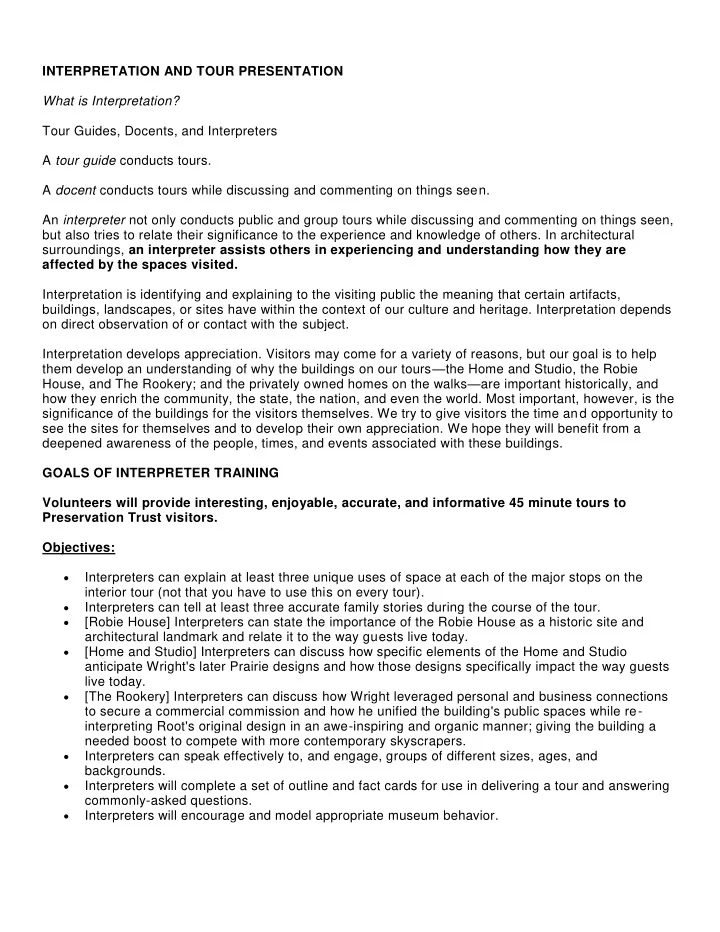

INTERPRETATION AND TOUR PRESENTATION What is Interpretation? Tour Guides, Docents, and Interpreters A tour guide conducts tours. A docent conducts tours while discussing and commenting on things seen. An interpreter not only conducts public and group tours while discussing and commenting on things seen, but also tries to relate their significance to the experience and knowledge of others. In architectural surroundings, an interpreter assists others in experiencing and understanding how they are affected by the spaces visited. Interpretation is identifying and explaining to the visiting public the meaning that certain artifacts, buildings, landscapes, or sites have within the context of our culture and heritage. Interpretation depends on direct observation of or contact with the subject. Interpretation develops appreciation. Visitors may come for a variety of reasons, but our goal is to help them develop an understanding of why the buildings on our tours — the Home and Studio, the Robie House, and The Rookery; and the privately owned homes on the walks — are important historically, and how they enrich the community, the state, the nation, and even the world. Most important, however, is the significance of the buildings for the visitors themselves. We try to give visitors the time and opportunity to see the sites for themselves and to develop their own appreciation. We hope they will benefit from a deepened awareness of the people, times, and events associated with these buildings. GOALS OF INTERPRETER TRAINING Volunteers will provide interesting, enjoyable, accurate, and informative 45 minute tours to Preservation Trust visitors. Objectives: Interpreters can explain at least three unique uses of space at each of the major stops on the interior tour (not that you have to use this on every tour). Interpreters can tell at least three accurate family stories during the course of the tour. [Robie House] Interpreters can state the importance of the Robie House as a historic site and architectural landmark and relate it to the way guests live today. [Home and Studio] Interpreters can discuss how specific elements of the Home and Studio anticipate Wright's later Prairie designs and how those designs specifically impact the way guests live today. [The Rookery] Interpreters can discuss how Wright leveraged personal and business connections to secure a commercial commission and how he unified the building's public spaces while re- interpreting Root's original design in an awe-inspiring and organic manner; giving the building a needed boost to compete with more contemporary skyscrapers. Interpreters can speak effectively to, and engage, groups of different sizes, ages, and backgrounds. Interpreters will complete a set of outline and fact cards for use in delivering a tour and answering commonly-asked questions. Interpreters will encourage and model appropriate museum behavior.
Volunteers understand their role in and value to the Frank Lloyd Wright Preservation Trust. Objectives: Volunteers will abide by the organization’s Code of Ethi cs. Volunteers will practice outstanding customer service. Volunteers will promote membership, programs, and donor and volunteer opportunities in a friendly and low-pressure manner. CUSTOMER SERVICE STATEMENT The Frank Lloyd Wright Preservation Trust has adopted the following customer service statement for the Preservation Trust: Customer Service is a consistent, positive effort put forth by every Preservation Trust volunteer and staff member to meet the expectations of our external and internal customers. Customer service includes, but is not limited to, the following traits and actions: Customer Service Traits Friendliness Efficiency Sensitivity Expertise Courtesy Patience Flexibility Receptiveness Promptness Enthusiasm Gratitude Hospitality Customer Service Actions smile treat each customer with respect and courtesy give each customer personal attention listen carefully identify customer needs and expectations provide accurate information respond promptly go the extra mile for extraordinary service share knowledge and excitement express appreciation offer products of value seek out and confirm information foster teamwork A Satisfied Customer has had his or her expectations addressed has received personal attention has been treated with appreciation and respect has his or her understanding and knowledge of Frank Lloyd Wright enhanced may serve as an ambassador for the Preservation Trust
External customers are visitors to the Home and Studio and Robie House, public program participants, members, donors, merchandise customers, community, neighbors, and media. Internal customers are volunteers, staff members, and board members, individually and collectively. The Preservation Trust is responsible for providing the resources, tools, and training that enable each volunteer to practice excellent customer service. [Return to Syllabus]
Recommend
More recommend